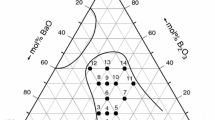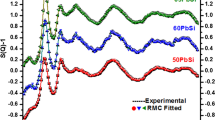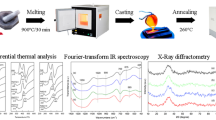Abstract
Lead-borate glasses manifest unique structure with lead oxide composition owing to their dual role of modifier and former. The medium-range signature from the first sharp diffraction peak (FSDP) in lead-borates exhibits substantial correlations due to the presence of superstructural units. Pressure plays an important role in altering bonding characteristics and hence structure in materials. To understand pressure-induced changes in the medium-range order (MRO) in lead-borate glasses, we have carried out high pressure X-ray diffraction studies in the FSDP region of these glasses up to 25 GPa. Two clear peaks, q0 and q1 are observed in all the modified glasses, below and above the position of the FSDP in pure B2O3 glass. This shows that lead oxide alters the FSDP and causes changes in the network structure at the MRO. q1 exhibits an increase under compression, resulting in a reduction in correlation lengths for all glass compositions. The initial steep decrease is accompanied by a lower rate of reduction at higher pressures. This shows that correlations arising from structural voids in the boron matrix exhibit similar decrease for various lead oxide compositions.
Similar content being viewed by others
Avoid common mistakes on your manuscript.
1 Introduction
The structure of glass is broadly classified as short-range and medium-range owing to the absence of any long-range order [1]. The short-range order (1–2 Å) arise from the nearest neighbour distances in the atomic polyhedral [1]. The medium-range order (MRO; 3–20 Å) depicts the next highest level of structural organization beyond the short-range order [1,2]. The characteristic appearance of Boson peak in the low-frequency Raman spectra and the first sharp diffraction peak (FSDP) in the low-q neutron and X-ray diffraction of glasses imply the presence of MRO in these materials [3]. The position and width of the FSDP infer the medium-range correlations in glasses [3].
The borate glass is a network of planar three-coordinated BO3 triangles, some of which group together to form planar boroxol (B3O6) rings [4]. These rings are responsible for the MRO in borate glasses. The inclusion of a modifier oxide converts some of these BO3 triangles into BO4− tetrahedral with partial transformation of rings into larger superstructural units, leading to MRO in the modified glasses. Borate and modified-borate glasses exhibit substantial MRO (up to ~20 Å) [5]. Network modifiers play important role in defining this order. Lead-oxide modifies the glass network uniquely owing to the dual role of Pb2+ cation, which behaves as a modifier at low oxide concentration and a glass former oxide itself at higher molar concentration [6].
Investigations on FSDP in B2O3 glasses at high pressures up to 9 GPa have shown that the MRO reorganizes by dissolution of boroxol rings [7]. Inelastic X-ray scattering studies on lithium and sodium-modified borate glasses under compression have shown the presence of three densification regimes in the short-range order according to the fractional presence of BO3 triangles [8]. However, MRO varies in a linear way in unmodified B2O3 glass with pressure. To our knowledge, there are no reports of pressure-dependence of MRO for modified borate glasses. It will be interesting to study the pressure variation of MRO in lead-modified borate glasses and investigate any correlations with the short-range order. With this aim, in this work we carried out high pressure X-ray diffraction (HPXRD) of the FSDP in lead-borate glasses to investigate pressure-induced changes in the MRO. We have studied low-q diffraction patterns in xPbO:(1−x)B2O3 (x = 0.3, 0.4 and 0.5) glasses under compression and monitored the changes in their correlation lengths.
2 Experimental
Lead-borate glasses with molar compositions xPbO:(1−x)B2O3 (x = 0.3, 0.4 and 0.5) were prepared by quenching the melt using reagent grade PbO and H3BO3 as starting materials [6,9]. A 10 g batch of precursors was weighed according to molar compositions, mixed well and homogenized. These materials were heated at 523 K for 10 h and further heated at 723 K for another 2 h. Finally, the mixture was melted at 1223 K for 20 min in a furnace and the melts were then poured on a stainless steel quenching plate kept at ambient and immediately pressed on by another, forming the glasses for the present study.
X-ray diffraction patterns of the samples were recorded using synchrotron source at Indus-2, RRCAT, Indore, with 17 keV X-ray photons of wavelength 0.72992 Å and detected using image plate detector [10]. HPXRD was carried out using a symmetric cell diamond anvil cell (DAC); the culet size of the anvils was 500 μm. The sample was placed on a stainless steel gasket with 250 μm hole size. Methanol:ethanol (4:1) was used as the pressure-transmitting medium and silver powder was used as pressure calibrant. The two-dimensional diffraction images were azimuthally integrated using the FIT2d software and analysed using Gaussian curve fitting at the FSDP to obtain the peak positions.
3 Results and discussion
The position of the first sharp diffraction peak (FSDP) is used to measure void periodicity in the network and indicates the presence of periodic structures in real space [3]. The FSDP of pure B2O3 glass occurs at q1 = 1.61 Å−1 [11]. The correlation length of void periodicity can be obtained from the FSDP position as 2π/q, so the medium range correlations in B2O3 glass appears at 3.9 Å.
In lead-borate glasses, as shown in figure 1, the FSDP region depicts multiple peaks. We observe two clear peaks, q0 and q1, one below and one above q1 of pure B2O3 glass, as shown in figure 1 in the pressure-variation of the low-q diffraction patterns in the glass with x = 0.3. Similar splitting of the FSDP was observed for all x. This shows that addition of PbO in B2O3 glass shrinks the original void periodicity as q1 is pushed to higher q, while generating new extended range correlations (q0) at lower q.
The position and intensity of the FSDP can be seen to be strongly dependent on the applied pressure (figure 1). q0 does not vary much with pressure; however, q1 increases under compression. We ascribe q1 to the cages without Pb2+ and arising from structural voids resulting from the arrangements of BO3 or B3O6 and other superstructural units present in the boron matrix. While q0 is ascribed to the correlations arising from rings of wider size originating from the structural modifications of the network by the lead cations [12]. Hence, Pb2+ enters the cages, displacing oxygen atoms to the boundaries and widening the voids. This results in extended correlations appearing as q0. Simultaneously, the cages without Pb2+ contract and appear as q1.
Figure 2 depicts the pressure dependence of void correlations obtained from q1. We have carried out experiments with increasing pressure up to 25 GPa. Here, we limit our discussion to q1 since it provides information of MRO in the superstructural units of the borate glass-forming network. It can be observed that the static correlation length, D, for q1 (q = 2π/D) exhibits a decrease with increasing pressure. This shows that correlations arising from structural voids in the boron matrix exhibit similar decrease for various lead oxide compositions. Furthermore, as the network is compressed, the voids (MRO) shrink by ~1 Å relative to their ambient length scales, as seen in figure 2. However, the MRO persists even at 25 GPa.
We also observe that there is an initial steep decrease, which is accompanied by a lower rate of reduction of correlation length at higher pressures. This means that the superstructural units rapidly come closer first and then there is a resistance. This resistance may correspond to three to four coordinated boron (BO3 to BO4−) change resulting in layered to three-dimensional network structure, as observed [7,8] for the short-range structural change with pressure. Such changes in MRO can be precursors to the local coordination transitions observed [8] under high pressures.
4 Conclusions
HPXRD studies on FSDP in lead-borate glasses were carried out to understand the pressure-induced changes in the MRO. Two clear peaks, q0 and q1, are observed in all the modified glasses, below and above the position of the FSDP in pure B2O3 glass. q1 exhibits an increase under compression, resulting in a reduction in correlation lengths for all glass compositions. We show that all glasses exhibit similar trend of reduction implying that MRO originating from borate void correlations respond similarly to pressure even when PbO is increased to 50 mol% in the structure. We observe an initial steep decrease, which is accompanied by a lower rate of reduction of correlation length at higher pressures, implying that the superstructural units rapidly come closer first and then there is a resistance. This may correspond to a change from three to four coordinated boron, resulting in layered to three-dimensional network structure. Such changes in MRO can be precursors to the local coordination transitions observed under high pressures.
References
Elliot S R 1991 Nature 354 445
Price D L 1996 Curr. Opin. Solid State Mater. Sci. 1 572
Sokolov A P, Kisliuk A, Soltwisch M and Quitmann D 1992 Phys. Rev. Lett. 69 1540
Wright A C 2015 Int. J. Appl. Glass Sci. 6 45
Surovstev N V 2000 J. Chem. Phys. 113 5891
Chakraborty S, Sivasubramanian V, Herojit Singh L, Venkata Krishnan R and Sinha A K 2017 J. Alloys Compd. 713 95
Zeidler A, Wezka K, Whittaker D A J, Salmon P S, Baroni A, Klotz S et al 2014 Phys. Rev. B 90 024206
Lee S K, Eng P J, Mao H-K and Shu J 2008 Phys. Rev. B 78 214203
Pisarski W A, Goryczka T, Wodecka-Dus B, Plonska M and Pisarska J 2005 Mater. Sci. Eng. B 122 94
Sinha A K, Sagdeo A, Gupta P, Upadhaya A, Kumar A, Singh M N et al 2013 J. Phys. Conf. Ser. 425 072917
Borjesson L, Hassan A K, Swenson J, Torrel L M and Fontana A 1993 Phys. Rev. Lett. 70 1275
Price D L, Ellison A J G and Saboungi M-L 1997 Phys. Rev. B 55 11249
Acknowledgements
We thank the staff at Indus-2 synchrotron for support during experiments. We also thank Awadhesh Mani Tiwari, N V Chandrasekhar and S Raju, Materials Science Group, for encouragement during the work.
Author information
Authors and Affiliations
Corresponding author
Additional information
This article is part of the Special issue on ‘High pressure materials science: recent trends’.
Rights and permissions
About this article
Cite this article
Chakraborty, S., Sivasubramanian, V., Singh, M.N. et al. Pressure-induced variations of medium-range order in B2O3 glasses. Bull Mater Sci 45, 190 (2022). https://doi.org/10.1007/s12034-022-02772-8
Received:
Accepted:
Published:
DOI: https://doi.org/10.1007/s12034-022-02772-8






